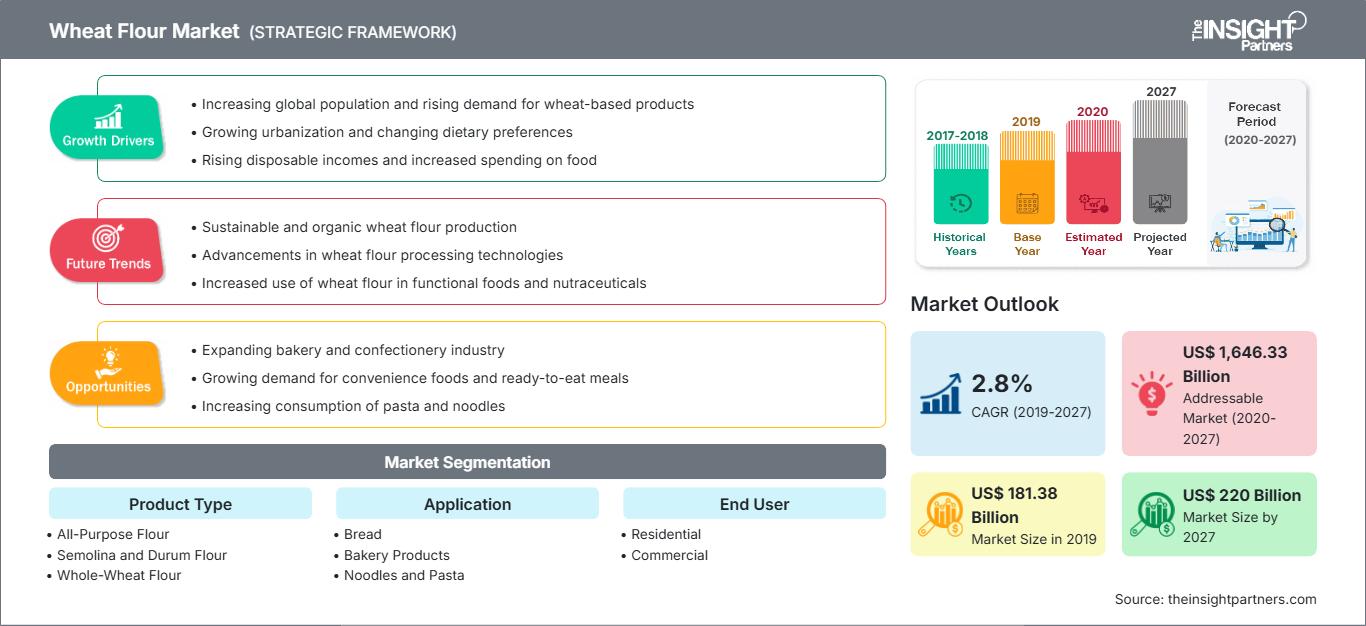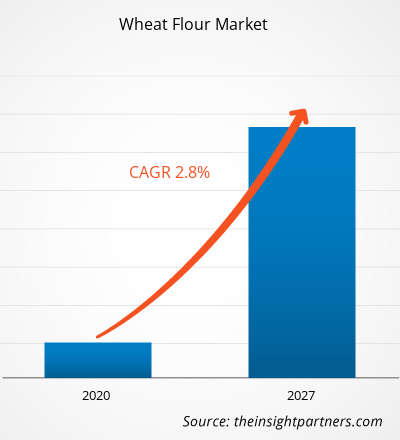밀가루 시장은 2019년 1,813억 7,766만 달러 규모였으며, 2027년에는 2,199억 9,542만 달러에 이를 것으로 예상됩니다. 2020년부터 2027년까지 연평균 성장률(CAGR) 2.8%로 성장할 것으로 예상됩니다. 밀가루 시장은 식품 가공 기술의 발전과 비건 제품에 대한 수요 증가에 힘입어 과거 엄청난 성장을 경험했습니다. 제빵류, 스낵, 면류, 파스타 등의 수요 급증 또한 밀가루 시장 성장을 촉진했습니다. 글루텐은 밀에 자연적으로 존재하는 단백질로, 반죽 시 반죽의 탄력을 높여 빵의 모양을 형성하는 데 중요한 역할을 합니다. 글루텐 함량은 밀가루 종류에 따라 다를 수 있습니다. 저글루텐 밀 품종은 "연질" 또는 "약질"로, 고글루텐 밀 품종은 "경질" 또는 "강질"로 불립니다. 빵은 다양한 식사와 요리의 일부이며, 소비자들 사이에서 밀빵에 대한 수요가 높습니다. 아시아 태평양 지역의 밀가루 시장은 예측 기간 동안 가장 높은 CAGR로 성장할 것으로 예상됩니다. 또한, 아시아 태평양 지역은 일상 식사에서 밀가루 소비가 증가하고 밀 생산 능력이 풍부하여 세계 밀가루 시장에서 가장 큰 점유율을 차지하고 있습니다. 중국과 인도는 세계 주요 밀 생산국 중 하나입니다. 중국은 2019년 아시아 태평양 밀가루 시장을 장악했으며, 2020년부터 2027년까지 시장을 선도할 것으로 예상됩니다. 중국 시장 성장은 주로 탄탄한 기반을 갖춘 식음료 부문과 혁신적인 밀가루 제품 개발에 대한 기업의 투자 증가에 기인합니다. 호주, 중국, 인도 등 아시아 국가의 소비자들이 점점 더 바쁜 생활 방식을 추구함에 따라, 조리 시간을 단축하고 즉석에서 음식을 섭취할 수 있는 간편식에 대한 선호도가 점차 높아지고 있습니다. 밀가루는 제빵류, 스낵, 면류, 파스타 등 다양한 간편식에 사용됩니다.
요구 사항에 맞게 이 보고서를 사용자 정의하십시오.
이 보고서의 일부, 국가 수준 분석, Excel 데이터 팩을 포함하여 모든 보고서에 대한 사용자 정의를 무료로 받을 수 있을 뿐만 아니라 스타트업 및 대학을 위한 훌륭한 제안 및 할인을 이용할 수 있습니다
밀가루 시장: 전략적 통찰력

-
이 보고서의 주요 주요 시장 동향을 확인하세요.이 무료 샘플에는 시장 동향부터 추정 및 예측에 이르기까지 데이터 분석이 포함됩니다.
시장 분석: 편의식품 수요 증가
밀가루에 대한 전 세계 수요는 꾸준히 증가하고 있으며, 이는 주로 소비자들이 편의식품과 가공식품에 대한 선호도가 높아짐에 따라 촉진되고 있습니다. 특히 도시 지역에서 생활 속도가 점점 빨라짐에 따라, 소비자들은 맛이나 품질은 그대로 유지하면서 조리가 간편한 식품을 선호하고 있습니다. 밀가루는 제빵 및 제과 제품, 즉석식품, 간식, 인스턴트 믹스 등 다양한 편의식품의 핵심 재료로 사용됩니다. 질감 개선, 결합력 향상, 유통기한 연장 등 기능적 특성 덕분에 현대 식품 가공에 필수적인 요소로 자리 잡았습니다.식음료 부문의 견고한 성장과 선진국 및 신흥 시장 모두의 호조로운 경제 여건은 편의식품 수요를 증폭시켰습니다. 맞벌이 가구 증가, 식생활 선호도 변화, 그리고 조리 시간 단축으로 인한 소비자 행동 변화가 이러한 추세에 크게 기여하고 있습니다. 더욱이, 급속한 도시화와 핵가족화는 편의식품을 현대 식단의 필수 요소로 자리매김하게 했습니다. 대형마트, 슈퍼마켓, 온라인 플랫폼, 편의점 등 다양한 유통 채널은 소비자의 즉석식품 접근성 확대에 중추적인 역할을 해왔습니다. 이러한 소매 유통의 발전은 제품 가시성을 높일 뿐만 아니라 밀가루 분야에서 브랜드 경쟁과 혁신을 촉진합니다.
클린 라벨 및 유기농 제품에 대한 수요 급증은 유기농 밀가루 제품의 출시로 이어졌고, 건강을 중시하는 소비자층 전반에 걸쳐 적용 범위가 더욱 확대되었습니다. 제조업체들은 영양 및 표시 요건을 충족하기 위해 유기농 또는 강화 밀가루로 제품을 재구성함으로써 이러한 변화를 활용하고 있습니다. 인구 증가, 가처분 소득 증가, 식품 선호도의 세계화와 같은 인구통계학적 요인 또한 수요 유지에 중요한 역할을 합니다. 이에 따라 주요 밀가루 생산업체들은 제품 제형 혁신, 생산 효율성 향상, 유통망 확장에 집중하여 국내외 시장에서 새로운 기회를 포착하고 있습니다. 따라서 편의식품에 대한 수요 증가는 밀가루 시장의 장기적인 성장 동력이 될 것으로 예상되며, 업계 이해관계자들은 민첩한 전략을 채택하고 생산 능력 확장, 연구 개발(R&D), 시장 진출 계획에 투자하고 있습니다.
제품 유형 분석
밀가루 시장은 제품 유형에 따라 다용도 밀가루, 빵가루, 세몰리나 및 듀럼가루, 통밀가루 등으로 세분화됩니다. 빵가루 부문은 2019년 시장에서 가장 큰 점유율을 차지했으며, 통밀가루 부문은 2020년부터 2027년까지 가장 빠른 연평균 성장률(CAGR)을 기록할 것으로 예상됩니다. 다용도 밀가루는 경질 밀과 연질 밀을 4:1 비율로 혼합하여 제조되며, 전 세계적으로 가장 널리 사용되는 밀가루로 여겨집니다. 다용도 밀가루는 밀 알갱이의 곱게 간 부분인 배유(endosperm)에서 추출되는데, 제분 과정에서 겨와 배아로부터 분리됩니다. 다용도 밀가루는 풍부한 영양 성분을 가지고 있으며, 니아신, 리보플라빈, 티아민, 엽산(비타민 B군)과 같은 비타민과 철분과 같은 미네랄의 풍부한 공급원입니다. 다용도 밀가루는 표백된 제품과 표백되지 않은 제품으로 시중에서 판매됩니다. 표백 과정에서 화학 물질이 방부제로 사용되어 밀가루에 이취가 생기거나 단기간 후 부패하는 것을 방지합니다. 다용도 밀가루는 케이크, 쿠키, 피자, 효모 빵, 비스킷, 머핀 등 모든 종류의 제빵류를 만드는 데 이상적이며, 그레이비와 소스에 걸쭉한 질감을 더하는 데에도 사용됩니다. 또한 육류, 채소 및 기타 제품을 튀기거나 볶을 때 코팅제로도 사용됩니다.최종 사용자 분석
밀가루 시장은 최종 사용자를 기준으로 가정용 및 상업용으로 구분됩니다. 상업용 부문은 2019년 시장 점유율이 가장 높았으며, 가정용 부문은 2020년부터 2027년까지 가장 높은 연평균 성장률을 기록할 것으로 예상됩니다. 식품 가공 산업의 성장과 건강하고 혁신적인 식품에 대한 수요 증가로 상업용 밀가루 수요가 급격히 증가했습니다. 상업용 부문은 호레카(HORECA), 기관 및 식품 서비스, 그리고 기타 제조업체로 세분화됩니다. 상업용 제분소는 소수의 첨가제를 첨가하여 밀가루를 가공합니다. 이 외에도, 밀가루를 하얗게 만들기 위해 가공 과정에서 과산화벤조일과 같은 표백제와 브롬산칼륨, 산화염소와 같은 산화제가 첨가됩니다. 밀가루는 빵, 케이크, 쿠키, 페이스트리, 머핀, 쿠키와 같은 식품 및 제빵류에 상업적으로 사용됩니다. 이 외에도 간식, 면, 파스타 등의 제조에도 널리 사용됩니다. 또한, 밀가루는 바이오 연료 산업과 사료용으로도 활용됩니다. 미국 농무부는 상업용 밀가루 검사와 관련하여 여러 표준을 채택했습니다. 이러한 표준은 밀가루 시장의 순도와 불순물 검출을 보장합니다.응용 분야 분석
밀가루 시장은 용도별로 빵, 제빵류, 면, 파스타 등으로 세분화됩니다. 빵 부문은 2019년 세계 밀가루 시장에서 가장 큰 점유율을 차지했으며, 제빵류 부문은 2020년부터 2027년까지 가장 높은 연평균 성장률을 기록할 것으로 예상됩니다. 밀가루는 빵 제조에 가장 흔히 사용되는 기본 재료입니다. 밀가루는 단백질의 주요 공급원이자 효모 발효 빵의 중요한 성분으로 여겨지는 글루텐으로 구성되어 있습니다. 글루텐은 고무질 물질로, 공기와 기체 분자를 가두어 빵 반죽에 구조와 탄력을 부여합니다. 이러한 작용은 구운 제품의 질감을 향상시킵니다. 다용도 밀가루, 흰 빵가루, 고운 프랑스 빵가루, 고글루텐 밀가루, 세몰리나 가루와 같은 밀가루는 다양한 종류의 빵 제조에 널리 사용됩니다. 이러한 밀가루는 개발 중인 빵의 종류에 따라 단독으로 사용하거나 다른 종류의 밀가루와 혼합할 수 있습니다. 아침 식사의 일부로 빵 소비가 증가하고 이와 관련된 급속한 혁신이 이루어짐에 따라 빵 제조에 사용되는 밀가루 수요가 증가할 것으로 예상됩니다.유통 채널 분석
유통 채널을 기준으로 밀가루 시장은 대형마트/슈퍼마켓, 편의점, 온라인 등으로 세분화되었습니다. 하이퍼마켓/슈퍼마켓 부문은 2019년 세계 밀가루 시장에서 가장 큰 점유율을 차지했으며, 예측 기간 동안 다른 유통 채널을 기반으로 한 시장이 가장 빠른 연평균 성장률(CAGR)로 성장할 것으로 예상됩니다. 제조업체는 소비자에게 제품을 쉽게 제공하기 위해 다양한 유통 채널을 선택합니다. 여러 유통 채널 중 슈퍼마켓과 하이퍼마켓의 중요성이 상대적으로 커졌습니다. 생산자는 수요에 따라 제품을 공급하는 유통업체에 제품을 판매합니다. 이는 이러한 매장에서 제품이 좋은 판매 이미지를 얻을 수 있다는 점에서 유리합니다. 또한, 생산이 수요에 따라 특정 수량으로만 이루어지기 때문에 제품 낭비가 없습니다. 또한, 이러한 매장은 구매자에게 다양한 제품을 동시에 제공하여 제품 간 비교가 용이하고 여러 브랜드에 대한 접근성을 높입니다. 하이퍼마켓과 슈퍼마켓을 통한 밀가루 판매는 빠른 속도로 성장하고 있으며, 하이퍼마켓과 슈퍼마켓의 증가는 이러한 성장에 긍정적인 영향을 미쳤습니다. 밀가루 종류는 전 세계 슈퍼마켓과 대형마트에서 쉽게 구입할 수 있습니다. 기업들은 합병과 인수, 연구 개발을 통해 전 세계적으로 사업 영역을 확장하는 것이 일반적입니다. Archer Daniels Midland Company, FoodMaven, ITC Limited와 같은 밀가루 시장 업체는 고객 기반을 확대하고 전 세계적으로 상당한 시장 점유율을 확보하기 위해 이러한 전략을 실행해 왔으며, 이를 통해 전 세계적으로 브랜드 이름을 유지할 수 있었습니다.- 2019년 7월, ITC Limited 산하의 Aashirvaad는 Aashirvaad Nature’s Super Foods의 산하에서 Gluten-Free Flour, Ragi Flour 및 Multi Millet Mix Flour로 구성된 새로운 제품군 출시를 발표했습니다.
- 2020년 2월, FoodMaven은 Ardent Mills, LLC의 사업부인 The Annex by Ardent Mills(The Annex)와 제휴하여 FoodMaven의 식품 서비스 고객에게 임시 밀가루를 판매한다고 발표했습니다.
- 2019년 9월, Archer Daniels Midland Company는 일리노이주 멘도타에 최첨단 밀가루 공장을 열었습니다. 북미에 건설된 제분소 중 가장 큰 규모입니다. 새롭게 건설된 3만 헥타르 규모의 제분 시설은 봄밀, 겨울밀, 연질밀 품종은 물론 두 종류의 통밀까지 제분할 수 있습니다.
The Insight Partners의 분석가들은 예측 기간 동안 밀가루 시장에 영향을 미치는 지역별 동향과 요인들을 면밀히 분석했습니다. 이 섹션에서는 북미, 유럽, 아시아 태평양, 중동 및 아프리카, 그리고 중남미 지역의 밀가루 시장 세분화 및 지역별 분포도 살펴봅니다.
밀가루 시장 보고서 범위
| 보고서 속성 | 세부 |
|---|---|
| 시장 규모 2019 | US$ 181.38 Billion |
| 시장규모별 2027 | US$ 220 Billion |
| 글로벌 CAGR (2019 - 2027) | 2.8% |
| 이전 데이터 | 2017-2018 |
| 예측 기간 | 2020-2027 |
| 다루는 세그먼트 |
By 제품 유형
|
| 포함된 지역 및 국가 |
북미
|
| 시장 선도 기업 및 주요 회사 프로필 |
|
밀가루 시장 참여자 밀도: 비즈니스 역학에 미치는 영향 이해
밀가루 시장은 소비자 선호도 변화, 기술 발전, 그리고 제품의 효능에 대한 인식 제고 등의 요인으로 최종 사용자 수요가 증가함에 따라 빠르게 성장하고 있습니다. 수요가 증가함에 따라 기업들은 제품 라인업을 확장하고, 소비자 니즈를 충족하기 위한 혁신을 추진하며, 새로운 트렌드를 적극 활용하고 있으며, 이는 시장 성장을 더욱 가속화하고 있습니다.

- 을 얻으세요 밀가루 시장 주요 주요 플레이어 개요
- 다용도 밀가루
- 빵가루
- 세몰리나 및 듀럼가루
- 통밀가루
- 기타
글로벌 밀가루 시장 - 최종 사용자별
- 가정용
- 상업용
글로벌 밀가루 시장 - 용도별
- 빵
- 베이커리 제품
- 국수 및 파스타
- 기타
글로벌 밀가루 시장 - 유통 채널별
- 하이퍼마켓/슈퍼마켓
- 편의점
- 온라인
- 기타
회사 프로필
- Archer Daniels Midland Company
- Acarsan Holding
- Allied Pinnacle
- Ardent Mills
- General Mills Inc
- George Weston Foods Limited
- ITC Limited
- The King Arthur Baking Company
- KORFEZ Flour Group
- Manildra Group
- 과거 분석(2년), 기준 연도, CAGR을 포함한 예측(7년)
- PEST 및 SWOT 분석
- 시장 규모 가치/거래량 - 글로벌, 지역, 국가
- 산업 및 경쟁 환경
- Excel 데이터세트
최근 보고서
사용 후기
구매 이유
- 정보에 기반한 의사 결정
- 시장 역학 이해
- 경쟁 분석
- 고객 인사이트
- 시장 예측
- 위험 완화
- 전략 기획
- 투자 타당성 분석
- 신흥 시장 파악
- 마케팅 전략 강화
- 운영 효율성 향상
- 규제 동향에 발맞춰 대응






















 무료 샘플 받기 - 밀가루 시장
무료 샘플 받기 - 밀가루 시장